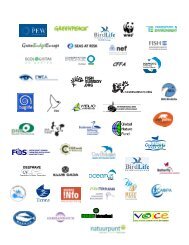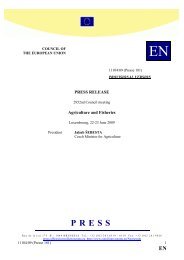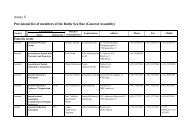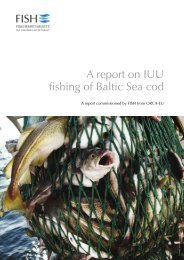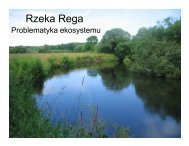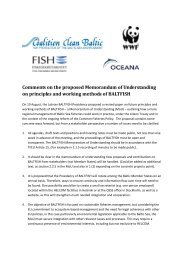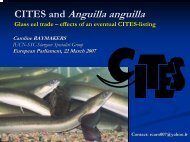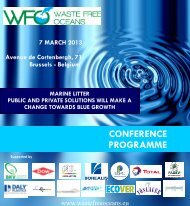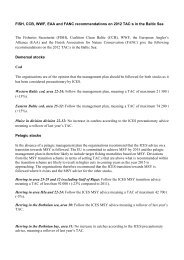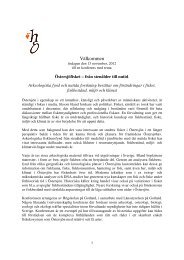Joint NGO paper for technical working group on discards - Fisheries ...
Joint NGO paper for technical working group on discards - Fisheries ...
Joint NGO paper for technical working group on discards - Fisheries ...
You also want an ePaper? Increase the reach of your titles
YUMPU automatically turns print PDFs into web optimized ePapers that Google loves.
This is a joint resp<strong>on</strong>se from Coaliti<strong>on</strong> Clean Baltic (CCB), the <strong>Fisheries</strong> Secretariat (FISH), the<br />
Swedish Society <str<strong>on</strong>g>for</str<strong>on</strong>g> Nature C<strong>on</strong>servati<strong>on</strong> (SSNC) and WWF to the BALTFISH discussi<strong>on</strong> <str<strong>on</strong>g>paper</str<strong>on</strong>g><br />
“Way <str<strong>on</strong>g>for</str<strong>on</strong>g>ward <str<strong>on</strong>g>for</str<strong>on</strong>g> discard-free Baltic Sea fisheries” prepared ahead of the BALTFISH meeting in May<br />
2012, as well as the BALTFISH <str<strong>on</strong>g>technical</str<strong>on</strong>g> <str<strong>on</strong>g>working</str<strong>on</strong>g> <str<strong>on</strong>g>group</str<strong>on</strong>g> discussi<strong>on</strong> <str<strong>on</strong>g>paper</str<strong>on</strong>g> “Implementati<strong>on</strong> of a ban<br />
<strong>on</strong> <strong>discards</strong> in the Baltic Sea” circulated ahead of the meeting in Tallinn <strong>on</strong> 28 August 2012.<br />
1. SUMMARY<br />
We str<strong>on</strong>gly support the initiative to employ the full range of measures to reduce bycatch and<br />
discarding, including fully documented fisheries and a future discard ban.<br />
It is our view that the compromise reached <strong>on</strong> EU implementati<strong>on</strong> of a discard ban in the<br />
Agriculture and <strong>Fisheries</strong> Council’s general approach <strong>on</strong> the proposal <str<strong>on</strong>g>for</str<strong>on</strong>g> a revised Regulati<strong>on</strong> of<br />
the Comm<strong>on</strong> <strong>Fisheries</strong> Policy includes unnecessary delays and loopholes. A Baltic Sea<br />
implementati<strong>on</strong> of the discard ban must aim to go bey<strong>on</strong>d the general framework agreed and<br />
ensure l<strong>on</strong>g-term sustainability.<br />
• The aim of any Baltic initiative must be to minimise unwanted catches, setting<br />
overarching targets as close to zero as possible.<br />
• We support a general discard ban by 2014 <str<strong>on</strong>g>for</str<strong>on</strong>g> all commercial fish species with a TAC and<br />
the fisheries that target those fish. A total discard ban, including all other species, should<br />
be introduced by 2015.<br />
• A Baltic Sea implementati<strong>on</strong> of a discard ban cannot stand al<strong>on</strong>e or be handled by simply<br />
lowering today’s minimum landing sizes but must be integrated and preceded by ef<str<strong>on</strong>g>for</str<strong>on</strong>g>ts<br />
to improve selectivity at sea, including the development of new gear.<br />
• All landed fish must be counted against the quota <str<strong>on</strong>g>for</str<strong>on</strong>g> that fish species, not against the<br />
TAC <str<strong>on</strong>g>for</str<strong>on</strong>g> the species targeted by the fishery ( i.e. we do not support Art 15.4).<br />
• We can support CCTV and not <strong>on</strong>ly <str<strong>on</strong>g>for</str<strong>on</strong>g> c<strong>on</strong>trol purposes but to gain knowledge and<br />
better data of the fishery.<br />
• Priority access to fisheries should be given to those who apply selective fishing practices,<br />
in order to reward best practice and ef<str<strong>on</strong>g>for</str<strong>on</strong>g>ts to avoid unwanted catches.<br />
1
2. BALTIC SEA FISHERIES - THE ISSUE<br />
We appreciate the attempt to provide an overview of the bycatch and <strong>discards</strong> of commercial<br />
fisheries in the Baltic Sea regi<strong>on</strong>. While the problem might be smaller than in other regi<strong>on</strong>s,<br />
particularly regi<strong>on</strong>s with mixed fisheries, the problems related to poor selectivity are not<br />
negligible and the use of t<strong>on</strong>nes in calculati<strong>on</strong>s can be misleading. For example, in 2009 ICES<br />
estimated that around 9 milli<strong>on</strong> cod were discarded. 1 This represented about 6.5% in weight but<br />
as much as 15% of the total number of cod caught and landed in 2009/2010. Today, these<br />
numbers are higher as evidence indicates that bycatch and discarding in the trawl fishery has<br />
increased with the increase in the eastern cod populati<strong>on</strong> and increasing flatfish stocks.<br />
We must also underline that although a lot of focus is directed towards the trawl fishery <str<strong>on</strong>g>for</str<strong>on</strong>g> cod,<br />
there are problems with bycatch of cod and salm<strong>on</strong> in the pelagic sprat and herring fisheries, as<br />
well as bycatch and discarding in the l<strong>on</strong>gline fishery. ICES estimates that as much as 250,000<br />
salm<strong>on</strong> are caught by pelagic vessels each year; in most cases they are not discarded but simply<br />
become an unrecorded part of the catch if the target fish is not <str<strong>on</strong>g>for</str<strong>on</strong>g> human c<strong>on</strong>sumpti<strong>on</strong>.<br />
This unwanted catch remains a problem <str<strong>on</strong>g>for</str<strong>on</strong>g> the stocks independent of whether we discard the<br />
fish or land it, as a large amount of juveniles are caught that will never enter the spawning stock.<br />
We would there<str<strong>on</strong>g>for</str<strong>on</strong>g>e like to emphasize that the problem needs to be solved at sea, through<br />
improved selectivity or a shift to more selective gear types. It is of utmost importance that future<br />
legal elements will support such a change, and not attempt to solve the problem solely through a<br />
discard ban.<br />
Finally, we want to point out that anecdotal numbers <str<strong>on</strong>g>for</str<strong>on</strong>g> current discarding vary greatly, and that<br />
it is quite possible that the estimates provided are much lower than the reality.<br />
3. TIME FRAME<br />
What would be the appropriate approach to launch a discard ban in the Baltic Sea – A gradual implementati<strong>on</strong>,<br />
in <strong>on</strong>e go by [1 January 2014] or to opt <str<strong>on</strong>g>for</str<strong>on</strong>g> a general ban <strong>on</strong> <strong>discards</strong><br />
We support a regi<strong>on</strong>alised approach to implementati<strong>on</strong> of the landing obligati<strong>on</strong>, rather than the<br />
piece-meal approach initially advocated by the Commissi<strong>on</strong>. The Council’s general approach has<br />
somewhat improved this particular element.<br />
It is our view that all species should be covered by the discard ban, and ultimately we would like<br />
it to cover all unwanted catches, with the excepti<strong>on</strong> of protected species and species with high<br />
survival rates. As STECF points out, this is very important from an en<str<strong>on</strong>g>for</str<strong>on</strong>g>cement perspective.<br />
There<str<strong>on</strong>g>for</str<strong>on</strong>g>e, a discard ban including all commercial fish species with a TAC regulati<strong>on</strong> and the<br />
fisheries targeting those stocks should be introduced by January 2014. A discard ban <str<strong>on</strong>g>for</str<strong>on</strong>g> all other<br />
fisheries and fish species, as well as n<strong>on</strong>-target species of fish and other organisms should be<br />
introduced by 2015.<br />
1 ICES WGBFAS report 2010 p 193<br />
2
4. NUMBER OF SPECIES/FISHERIES SUBJECT TO OBLIGATION TO LAND<br />
Which species should be included in the discard ban Sprat, salm<strong>on</strong>, other flatfish than plaice, all commercial<br />
species Is a fisheries approach more feasible than a species approach in the Baltic Sea<br />
In the Commissi<strong>on</strong> proposal (COM(2011)425, Article 15), <strong>on</strong>ly some of the commercial fish<br />
species in the Baltic were covered by the landing obligati<strong>on</strong>. All commercial species must be<br />
covered by the discard ban. We also recommend that the landing obligati<strong>on</strong> be extended to cover<br />
both fish (commercial and n<strong>on</strong>-commercial) and n<strong>on</strong>-fish species. Extending the landing<br />
obligati<strong>on</strong> would enable scientists to have better in<str<strong>on</strong>g>for</str<strong>on</strong>g>mati<strong>on</strong> regarding the impact of fishing<br />
activities <strong>on</strong> the marine envir<strong>on</strong>ment, and would also allow them to be better in<str<strong>on</strong>g>for</str<strong>on</strong>g>med when<br />
recommending fishing quotas to Council.<br />
In terms of fisheries c<strong>on</strong>tra species approach, we support a fishery-by-fishery approach in the<br />
Baltic Sea, including the obligatory landing of n<strong>on</strong>-commercial and n<strong>on</strong>-target species. If this is<br />
not possible, a practical soluti<strong>on</strong> linked to other management tools such as multiannual plans<br />
(MAPs) may work best. Multiannual plans (MAPs) should include tools and timelines that help<br />
eliminate unwanted catches (Article 11e). These would need to be complemented by effective<br />
m<strong>on</strong>itoring and en<str<strong>on</strong>g>for</str<strong>on</strong>g>cement measures. However, acti<strong>on</strong>s cannot be delayed because of a lack of<br />
MAPs or other regulati<strong>on</strong>s, as the current wording in the general approach seem to suggest.<br />
5. EXEMPTION OF FISHERIES OR SPECIES<br />
Possible candidates <str<strong>on</strong>g>for</str<strong>on</strong>g> exempti<strong>on</strong>s from the discard ban in terms of fisheries (gear), species or de minimis. This<br />
list would be subject to scientific review, and a request could be <str<strong>on</strong>g>for</str<strong>on</strong>g>warded to ICES.<br />
We support exempti<strong>on</strong>s <str<strong>on</strong>g>for</str<strong>on</strong>g> “prohibited species” – as l<strong>on</strong>g as the catch is still recorded – and <str<strong>on</strong>g>for</str<strong>on</strong>g><br />
species or categories of catch with high survival rates up<strong>on</strong> release. The damage to fish caught in<br />
trawls is quite different from damage to trapped fish and hooked fish. If there is a high<br />
probability of survival, releasing of juveniles or n<strong>on</strong>-target fish species can be a feasible opti<strong>on</strong><br />
but it has to be supported by scientific studies showing high survival rates. However, it is hard to<br />
see how the release of some fish can be c<strong>on</strong>trolled, without risking c<strong>on</strong>tinued discarding and/or<br />
high grading of other fish, so the matter has to be dealt with in a very careful way.<br />
We are not in favour of the de minimis exempti<strong>on</strong> proposed by the Council in its general<br />
approach, particularly as the estimated discarding in some key Baltic fisheries are within this 5%<br />
range and the different situati<strong>on</strong>s listed as possible reas<strong>on</strong>s <str<strong>on</strong>g>for</str<strong>on</strong>g> this exempti<strong>on</strong> are all difficult to<br />
judge in a n<strong>on</strong>-subjective way – and could there<str<strong>on</strong>g>for</str<strong>on</strong>g>e lead to a difference in interpretati<strong>on</strong> in<br />
different countries with an unlevel “playing field” as a result. Neither do we support the<br />
proposed derogati<strong>on</strong> from the obligati<strong>on</strong> to count catches against the relevant quotas.<br />
6. UNWANTED CATCHES<br />
Are the abovementi<strong>on</strong>ed mechanisms sufficient to ensure a match between available quotas and the actual fishing<br />
pattern<br />
3
1) We do not support a general increase in TAC to compensate <str<strong>on</strong>g>for</str<strong>on</strong>g> catches, including undersized<br />
fish, counting against the quota under a discard ban. Even with “fully documented fisheries”, we<br />
do not believe that a landing obligati<strong>on</strong> should automatically result in a higher TAC. There are<br />
several aspects to c<strong>on</strong>sider:<br />
a) Whether an increase would be appropriate depends <strong>on</strong> whether the stock is well managed and<br />
management targets have already been reached, such as MSY by 2015 as well as more ambitious<br />
l<strong>on</strong>g-term targets. If this is not the case, the TAC should definitely not be increased.<br />
b) To simply add the best estimate <str<strong>on</strong>g>for</str<strong>on</strong>g> current <strong>discards</strong> to the TAC would also remove a major<br />
incentive to develop more selective ways of fishing. It could also lead to misreporting of<br />
unwanted catches in the years leading up to the discard ban, in order to inflate the future TAC.<br />
Instead of simply increasing the overall TAC, a special credit/premium/priority access could be<br />
granted to those using the most selective gear/best practices. This would indeed strengthen the<br />
incentive to shift to more selective ways of fishing.<br />
2) We believe that the overall resp<strong>on</strong>sibility <str<strong>on</strong>g>for</str<strong>on</strong>g> allocating fishing possibilities under the nati<strong>on</strong>al<br />
TAC should remain with Member States, but it has to be recognised that different countries do<br />
this in different ways. Not all allocate fishing possibilities to specific vessels. The idea, as worded<br />
here also goes against the basic aim of the discard ban, which must be to change the expected<br />
species compositi<strong>on</strong> of different fisheries in order to reduce unwanted bycatch and the<br />
underlying reas<strong>on</strong>s <str<strong>on</strong>g>for</str<strong>on</strong>g> discarding. The fisheries need to adapt to the new rules, not the rules to<br />
the existing fisheries.<br />
Of the four specific instruments proposed, improvement of selective gear is key, pooling quotas<br />
could certainly be useful <strong>on</strong> the level of POs or equivalent, and quota swaps may play a useful<br />
role particularly in the first years of implementati<strong>on</strong>. Regarding the 10% year-to-year flexibility,<br />
the percentage seems high c<strong>on</strong>sidering the current estimates <str<strong>on</strong>g>for</str<strong>on</strong>g> unwanted catches and discarding<br />
in the Baltic fisheries. In order to create str<strong>on</strong>g incentives <str<strong>on</strong>g>for</str<strong>on</strong>g> improving selectivity, it should be<br />
lower. Also, it has to be carefully c<strong>on</strong>trolled that Member States using this instrument really<br />
deducts any overshoot in TAC from the next years catch opportunities.<br />
3) We do not support the possibility to deduct unwanted catches [of other commercial species]<br />
against the quota of the target species – regardless of the percentage proposed. This would<br />
muddle up the useful in<str<strong>on</strong>g>for</str<strong>on</strong>g>mati<strong>on</strong> that can be gained from a discard ban, which may help<br />
improve scientific data and assessments. How unwanted catches of n<strong>on</strong>-target, n<strong>on</strong>-commercial<br />
species and organisms should be handled if the discard ban is universal will need to be discussed<br />
in more detail, but in general we support a system where the unwanted catch is utilized but<br />
without ec<strong>on</strong>omic benefit <str<strong>on</strong>g>for</str<strong>on</strong>g> the fishermen. Profits should be used e.g. <str<strong>on</strong>g>for</str<strong>on</strong>g> c<strong>on</strong>trol or data<br />
collecti<strong>on</strong>.<br />
We want to underline that whatever model or system used, the undersized or unwanted catch<br />
must always be counted against the quota of the specific species in questi<strong>on</strong>.<br />
4
7. IMPROVEMENT OF SELECTIVITY<br />
Suggesti<strong>on</strong>s <str<strong>on</strong>g>for</str<strong>on</strong>g> improving selectivity of gear, e.g. including hook/bait sizes in salm<strong>on</strong> fishery<br />
Increased selectivity is about addressing the underlying problem of unwanted catches causing<br />
unnecessary mortality. We str<strong>on</strong>gly support a c<strong>on</strong>tinuous improvement of gear, in line with best<br />
available technology. There is also a need to further develop alternative gear types, primarily n<strong>on</strong>trawling<br />
alternatives. For example, traps or “pots” <str<strong>on</strong>g>for</str<strong>on</strong>g> catching cod in the Baltic Sea (successful<br />
trials have been per<str<strong>on</strong>g>for</str<strong>on</strong>g>med by the Swedish Board of <strong>Fisheries</strong>) do not <strong>on</strong>ly make it possible to<br />
release undersized fish relatively unharmed but also saves the fish from being eaten or damaged<br />
by seals.<br />
Regarding the trawl fisheries <str<strong>on</strong>g>for</str<strong>on</strong>g> cod, recent studies underline the problems of BACOMA and<br />
T90. We support further careful investigati<strong>on</strong> and EMFF funding of how the situati<strong>on</strong> can be<br />
improved, and follow the current project <strong>on</strong> possibilities to minimize <strong>discards</strong> closely. One must<br />
also c<strong>on</strong>sider whether it is worth it making adjustments to trawls rather than shifting to other<br />
gear types.<br />
We support the establishment of selectivity goals and the creati<strong>on</strong> of a regi<strong>on</strong>al road map setting<br />
out how to reach these goals. A first step would be to set as a goal to reduce the catches of<br />
juvenile cod (under 38 cm) in trawl fisheries to max 5%. All landings must be reported and<br />
c<strong>on</strong>trolled to keep track of the size of fish caught, and separati<strong>on</strong> of undersized fish must be<br />
ensured.<br />
We also believe that other measures can be implemented to improve selectivity, such as “moving<br />
<strong>on</strong>” measures and real-time spatial closures triggered by high levels of juveniles/undersized fish<br />
in a particular area. Less<strong>on</strong>s should be learnt from other areas where moving <strong>on</strong> provisi<strong>on</strong>s are<br />
already in place, such as the North Sea.<br />
Finally, fishermen that show the best per<str<strong>on</strong>g>for</str<strong>on</strong>g>mance should be given priority access to the<br />
resource, through extra quota or credit.<br />
8. MINIMUM CONSERVATION REFERENCE SIZES (MCRS)<br />
Should the current minimum sizes in the Baltic Sea <str<strong>on</strong>g>for</str<strong>on</strong>g> human c<strong>on</strong>sumpti<strong>on</strong> purposes be replaced by MCRS,<br />
abolished or revised<br />
Whether we call a minimum legal landing/selling size a minimum landing size (MLS) or<br />
minimum c<strong>on</strong>servati<strong>on</strong> reference size (MCRS) is not really important. A “cosmetic” change from<br />
minimum landing size to something else might be necessary with an obligati<strong>on</strong> to land all catches,<br />
but it is the purpose of the limit itself and how it is established that is important. We should not<br />
abolish a minimum size – it is an important management tool, particularly in fisheries below<br />
sustainable populati<strong>on</strong> levels.<br />
We do not support a reducti<strong>on</strong> of the current minimum landing sizes (MLS) in the Baltic regi<strong>on</strong>,<br />
as this would create incentives to catch more juvenile fish. The definiti<strong>on</strong> of the proposed<br />
minimum c<strong>on</strong>servati<strong>on</strong> reference size (MCRS) is somewhat unclear, but we believe it must have a<br />
5
iological basis, and we believe there must be a limit size. The Commissi<strong>on</strong> is proposing that all<br />
fish below the MCRS should be marketed at a lower value.<br />
In the Council debates <strong>on</strong> the discard ban, many ministers have been heard saying that it is<br />
central to implement it in such a way that it does not lead to a new market <str<strong>on</strong>g>for</str<strong>on</strong>g> juvenile fish,<br />
thereby creating incentives to catch what is currently “unwanted catches”. A reducti<strong>on</strong> of the<br />
minimum reference size <str<strong>on</strong>g>for</str<strong>on</strong>g> Baltic cod would do just that, as in some Member States the<br />
processing industry has indicated a demand <str<strong>on</strong>g>for</str<strong>on</strong>g> undersized fish, and there are markets <str<strong>on</strong>g>for</str<strong>on</strong>g> this<br />
fish already today.<br />
Any revisi<strong>on</strong>s of reference sizes should be based <strong>on</strong> scientific advice <strong>on</strong> maturati<strong>on</strong> age and size,<br />
enabling fish to spawn at least <strong>on</strong>ce be<str<strong>on</strong>g>for</str<strong>on</strong>g>e being targeted in the fishery.<br />
9. CONTROL<br />
What kind of measures are necessary to properly c<strong>on</strong>trol and m<strong>on</strong>itor a discard ban in the Baltic Sea<br />
With a discard ban, c<strong>on</strong>trol and en<str<strong>on</strong>g>for</str<strong>on</strong>g>cement will become more important. Experiences from<br />
other countries show that some of the incentives to discard, such as highgrading, remain and will<br />
not automatically disappear.<br />
We support the idea of CCTV as a c<strong>on</strong>trol measure. Projects have shown that its usage can be<br />
both effective and positive. However, we d<strong>on</strong>’t see CCTV as a soluti<strong>on</strong> to minimising the<br />
problem of catching undersized fish. This problem should primarily be addressed through<br />
improved selectivity. CCTV cameras can then be used as a measure in order to ensure<br />
compliance by the industry, and a very str<strong>on</strong>g argument <str<strong>on</strong>g>for</str<strong>on</strong>g> both CCTV and the landing<br />
obligati<strong>on</strong>s is to greatly improve data <strong>on</strong> all catches and bycatch of n<strong>on</strong> fish species as well.<br />
Compulsory VMS can be a complimentary measure, as <strong>on</strong>e would also be able to document<br />
where fishing takes place, which would inter alia have the advantage of providing scientists with<br />
improved data. We there<str<strong>on</strong>g>for</str<strong>on</strong>g>e propose that all vessels using active/towed gear should be fitted<br />
with VMS. It would be even better if the same system could be applied to the fishing sector as<br />
<str<strong>on</strong>g>for</str<strong>on</strong>g> other vessel traffic.<br />
6



